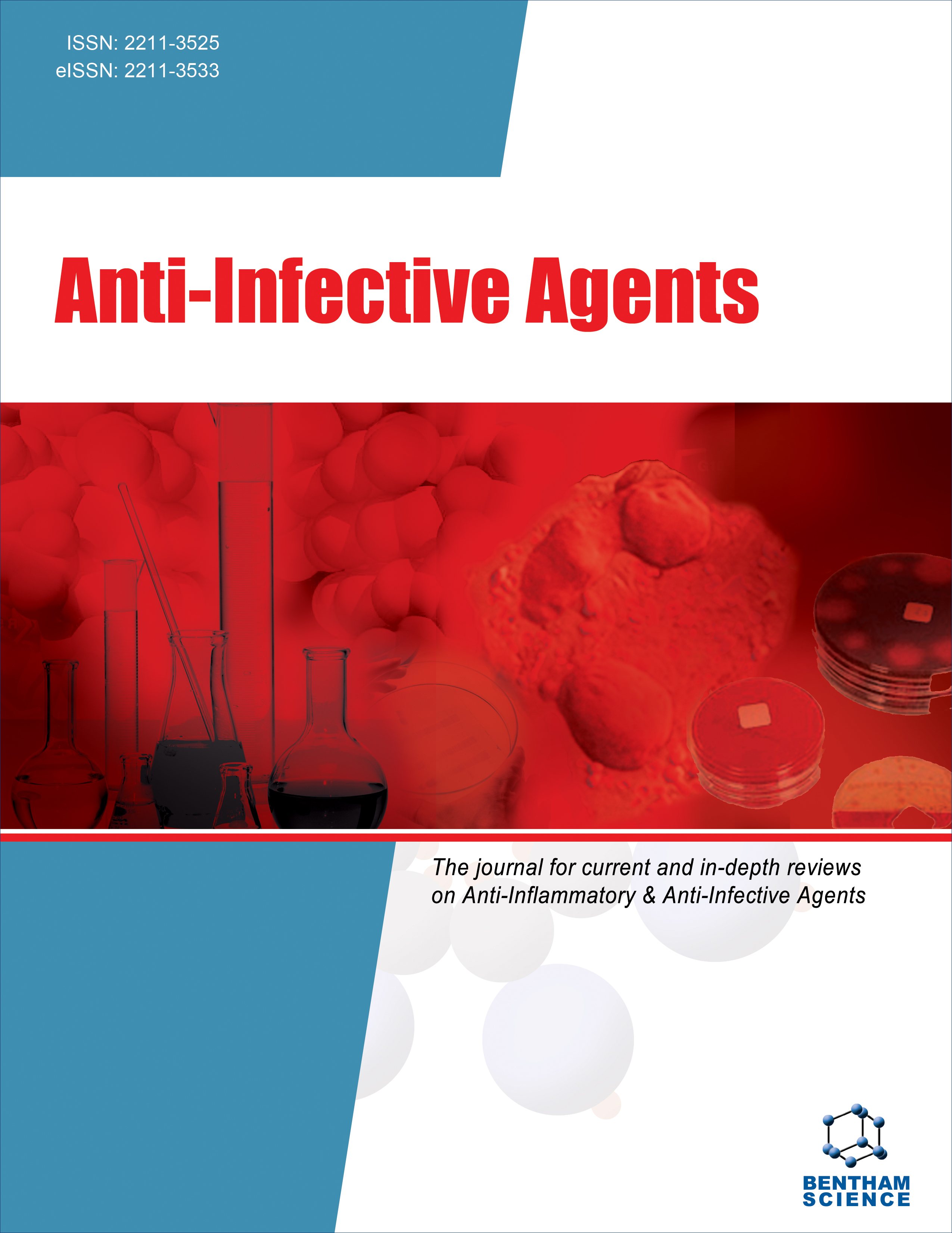- Home
- A-Z Publications
- Anti-Infective Agents
- Previous Issues
- Volume 20, Issue 3, 2022
Anti-Infective Agents - Volume 20, Issue 3, 2022
Volume 20, Issue 3, 2022
-
-
Secretory Profile of Selected Gut Bacteria of Cockroaches: A Potential Source of Anti-Infective Agents
More LessPests, such as cockroaches, thrive in polluted conditions that are detrimental to Homo sapiens, suggesting that such species possess mechanisms to protect themselves against pathogens. Besides their immunity to fight pathogens, we hypothesize that the microbial gut flora of pests produces antimicrobials to thwart communicable diseases. It is proposed that the search for new antimicrobials originating from unusual sources Read More
-
-
-
A Review on Potential Activities of Different Parts of Cassia sophera as Antidiabetic, Antimicrobial and Anticancer Agent
More LessAuthors: Atyurmila Chakraborty, Sasmita K. Acharjya, Bimala Tripathy and Dipthi ShreeBackground: Herbal medicines are one of the giant creations of nature. Several medicinal agents developed from natural sources, which open a new era of health sciences. Cassia sophera is a prevalent medicinal plant that is locally known as “Kasondi”, belonging to the family Caesalpinaceae. Many secondary metabolites like alkaloids, tannins, anthraquinones, flavonoids are isolated from roots, stems, leaves, fl Read More
-
-
-
Natural Products for Targeting Acanthamoeba spp.
More LessPathogenic Acanthamoeba is responsible for causing serious eye and fatal brain infections. A successful prognosis remains elusive despite advances in chemotherapeutics and supportive care. Natural products of medicinal value remain a promising source for drug development due to their broad-spectrum antimicrobial activities. Herein, we discuss anti-Acanthamoebic properties of natural products originating from pla Read More
-
-
-
Disulfiram: A Repurposed Drug in Preclinical and Clinical Development for the Treatment of Infectious Diseases
More LessAuthors: Marco M. Custodio, Jennifer Sparks and Timothy E. LongThis article reviews preclinical and clinical studies on the repurposed use of disulfiram (Antabuse) as an antimicrobial agent. Preclinical research covered on the alcohol sobriety aid includes uses as an anti-MRSA agent, a carbapenamase inhibitor, antifungal drug for candidiasis, and treatment for parasitic diseases due to protozoa (e.g., giardiasis, leishmaniasis, malaria) and helminthes (e.g., schistosomiasis, trichuriasis). Past, c Read More
-
-
-
Combretastatin Derivatives as Microtubule Inhibitors of Colchicines Binding Site
More LessBy Adarsh SahuThe colchicine binding site in microtubules is the most flourishing target for anticancer treatment. Microtubule inhibitor drugs, including paclitaxel and vinca alkaloids, have been considered to exert their activity primarily by increasing or decreasing the cellular microtubule mass. This review describes the microtubular assembly along with the combretastatin derivatives as microtubules inhibitors, the structures of compounds Read More
-
-
-
Use of the Genus Satureja as Food Supplement: Possible Modulation of the Immune System via Intestinal Microbiota During SARS-CoV-2 Infection
More LessSatureja genus belongs to the Lamiaceae family, and they are used in food products and by pharmaceutical and cosmetic industries. The chemical composition of Satureja is responsible for its pharmacological and phytochemical properties. Among the various biological activities, notably antioxidant, antibacterial and antifungal, Satureja also has a potential antiviral activity. The existence of a microbiota modulation potenti Read More
-
-
-
Synthesis of Quinine-Triazole Derivatives (QNTDs) with Antifungal Potency
More LessAuthors: Adarsh Sahu and Ramkishore AgrawalBackground: Reduced efficacy of the available antifungal drugs is the major public health concern of the population all over the world. Despite significant advances in the treatment of these life-threatening infections, severe toxicity and increasing median effective dose have limited the efficacy of frontline therapy applicable against them. Objective: The quintessential occurrence of systemic toxicity handicaps the clinical Read More
-
-
-
In silico Design, Synthesis and Antitubercular Activity of Some Metal Complexes Derived from Salicylaldehyde and Amino Acid
More LessBackground: A new series of copper (II), cobalt (II), zinc (II), manganese (II), and iron (II) metal complexes were synthesized by the condensation of a novel Schiff base with various metal chlorides in ethanol. Schiff base was synthesized by reacting salicylaldehyde with Lglutamic acid and L-tyrosine dissolved in ethanol, respectively. Methods: The structures of all the synthesized metal complexes (4a-e, 7a-e) were investigate Read More
-
Volumes & issues
Most Read This Month
Article
content/journals/aia
Journal
10
5
false
en


